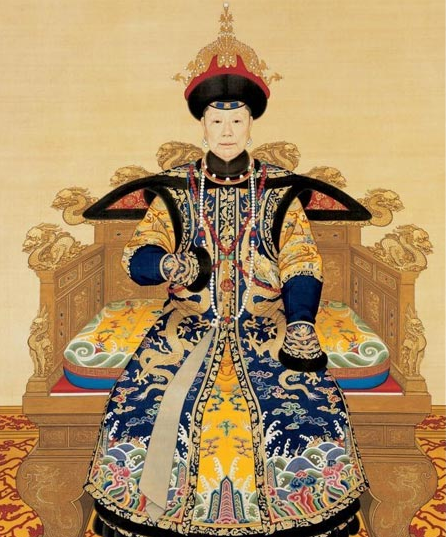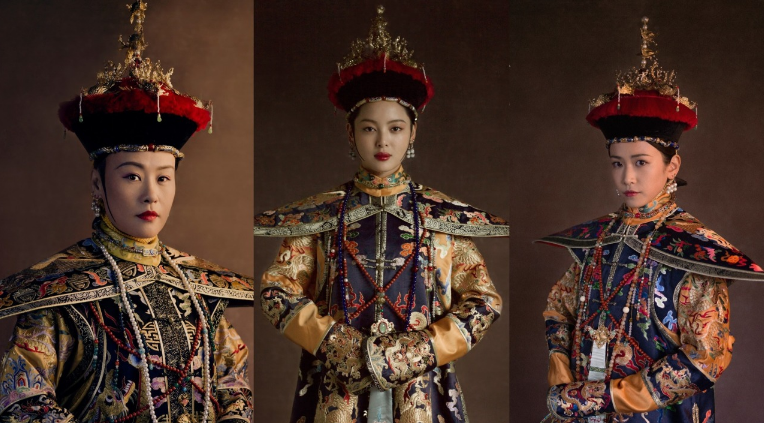The Qing court wore traditional Manchu attire, known as Qizhuang, featuring full-length robes, boots, trousers, and functional riding coats.
Imperial Attire and Symbols
The Qing Dynasty, a period marked by cultural richness and opulence, distinguished itself through its imperial attire and symbols. These elements not only represented authority but also conveyed deep cultural and spiritual meanings.
Emperor’s Dragon Robe and Its Significance
The Dragon Robe, worn exclusively by the Emperor, stands as a symbol of supreme power and celestial favor. This ornate garment, meticulously crafted, features dragons, the quintessential emblem of imperial strength and divine protection. The robe’s vibrant colors and intricate patterns, often against a yellow background, signify prosperity and fortune. Dragons in Chinese culture symbolize power, strength, and good luck for those worthy of it, making them an ideal representation for the Emperor.

Empress’s Phoenix Gown and Cultural Meaning
Equally magnificent, the Empress’s Phoenix Gown serves as a counterpart to the Emperor’s robe. Embroidered with phoenixes, this gown embodies grace, benevolence, and the union of yin and yang. The phoenix, revered in Chinese mythology, is a sign of high virtue and grace, often associated with the Empress. The gown, usually adorned with motifs of peonies or other auspicious symbols, reflects the Empress’s role in bringing balance and harmony to the imperial household.
Each stitch and color choice in these imperial garments carries profound meaning, linking the Qing court’s aesthetic choices with their deep-rooted philosophies and beliefs. The attire of the Emperor and Empress not only showcases their status but also serves as a canvas for expressing the dynasty’s values and ideologies.
Court Dress for Officials
In the Qing Dynasty, the court dress of officials was a complex system, rich in symbolism and hierarchy. This attire not only marked their status but also reflected the intricate social order within the imperial court.
Ranking System and Corresponding Attire
Officials’ ranks in the Qing court were distinctly represented through their attire. High-ranking officials donned robes adorned with specific motifs, like cranes or peonies, indicating their rank and position. The color of these robes, typically ranging from dark blue to bright red, varied based on rank and function. Mandarin squares or ‘rank badges’ were a crucial part of these robes, each featuring a specific bird or animal, symbolizing the official’s rank.
Headwear and Accessories for Different Ranks
Headwear played a crucial role in the Qing official’s dress. Hats, often made of silk or felt, were adorned with jade or gold finials, varying according to rank. The most distinguished officials wore hats with elaborate wing-like flaps and precious stones. Accessories like belts, boots, and jade pendants further emphasized their status and rank. The quality and intricacy of these accessories directly correlated with the official’s position, showcasing not only their rank but also the meticulous craftsmanship and cultural richness of Qing attire.
Seasonal Variations in Court Attire
The Qing Dynasty’s court attire beautifully adapted to the changing seasons, reflecting both practical needs and aesthetic preferences. This variation ensured comfort while maintaining the elegance and symbolism crucial to imperial clothing.
Summer and Winter Court Dress Differences
For summer, court dresses were lighter and airier, often made from thin silks or gauze. These garments allowed for better air circulation, crucial in the hot, humid climate. In contrast, winter attire was heavier and more insulating, often made from thicker fabrics like brocade or fur-lined silk. These garments were not only warm but also showcased the wealth and status of the wearer through their luxurious materials.
Fabric Choices for Seasonal Comfort
The choice of fabrics played a key role in seasonal comfort. Summer robes often featured lightweight silk, known for its breathability and soft texture. For additional cooling, some garments incorporated fine bamboo or reed linings. Winter garments, on the other hand, favored materials like brocade, velvet, and furs, providing warmth and showcasing intricate designs. The careful selection of these materials underlines the Qing Dynasty’s commitment to combining practicality with the grandeur befitting their imperial status.
Ceremonial Outfits for Special Occasions
The Qing Dynasty’s ceremonial attire was a vivid display of tradition, status, and cultural identity, designed specifically for various significant events and rituals.
Wedding Attires in the Qing Court
Royal weddings showcased some of the most elaborate attires. The bride and groom wore specially designed robes, often red for good luck and joy. The bride’s gown, adorned with auspicious symbols like phoenixes and dragons, symbolized the union of two families and their hopes for prosperity. The groom’s attire, equally magnificent, often featured dragon motifs and fine embroidery, signifying his role in the lineage.
Attire for Religious and State Ceremonies
For religious and state ceremonies, officials and royalty donned garments that reflected their rank and the nature of the event. These outfits, often in specific colors like yellow or purple, were adorned with intricate patterns and symbols signifying their roles and responsibilities. The use of silk and precious stones in these garments highlighted the solemnity and importance of these ceremonies. The meticulous design of these outfits mirrored the Qing Dynasty’s deep respect for tradition and the ceremonial aspects of governance.
Influence of Manchu Culture on Qing Dynasty Fashion
The Manchu culture significantly influenced Qing Dynasty fashion, introducing new styles and customs that blended with traditional Han clothing, creating a unique sartorial blend.
Adoption of Manchu Styles in Han Garments
The integration of Manchu styles into Han garments led to a distinct fashion evolution. The Han Chinese adopted the Manchu-style robe, known as the ‘Changshan’ for men and ‘Qipao’ or ‘Cheongsam’ for women. These garments, characterized by their high collars and straight cuts, differed significantly from the previously worn Hanfu. The Manchu influence also introduced new embroidery techniques and patterns, adding richness and diversity to the fabric’s designs.

Significance of the Queue Hairstyle
The Queue hairstyle, a Manchu-origin hairstyle, became a symbol of Qing rule. It featured shaved foreheads and a braided pigtail, signifying submission to the Manchu regime. This hairstyle, mandatory for Han men, marked a profound cultural shift and became a contentious symbol of Manchu authority over Chinese subjects. The queue’s adoption demonstrates how fashion and appearance were used to assert political control and cultural assimilation during the Qing Dynasty.
Evolution of Qing Court Dress Over Time
The Qing Dynasty witnessed a dynamic evolution in court dress, reflecting changing political, social, and cultural landscapes over its reign.
Early vs Late Qing Dynasty Fashion Trends
In the early Qing period, court fashion largely adhered to traditional Manchu styles, characterized by robes with horse-hoof cuffs and a straight silhouette. As the dynasty progressed, particularly in the late Qing, fashion began incorporating Han elements, leading to a more blended style. This evolution reflected the gradual merging of Manchu and Han cultures, showcasing a rich tapestry of cultural interplay in clothing.
Western Influences in the Late Qing Period
The late Qing Dynasty saw the introduction of Western influences in court attire. Western-style military uniforms and formal wear began to appear, especially among the elite and those with foreign education. This shift was not just stylistic but also indicated a broader openness to international influences and modernization efforts within the Qing court. This period marked a significant transition, as traditional Chinese attire began to assimilate aspects of Western fashion, signaling a new era in Chinese sartorial history.







